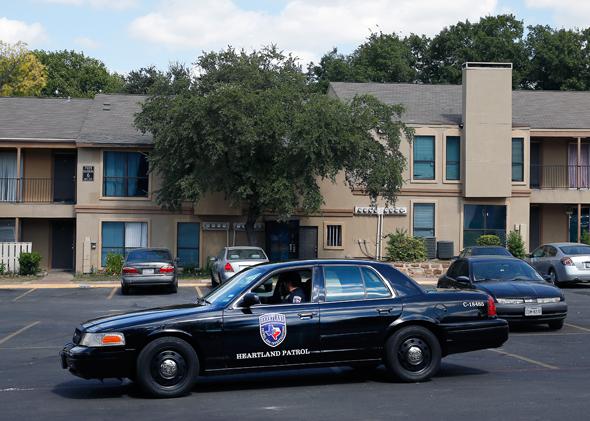Nurse’s lounges and patient wards were calm at Texas Health Presbyterian Hospital in Dallas on Wednesday. Staff came in for normal shifts, and doctors made their usual rounds. No one came in panicked about having contracted Ebola, says Wendell Watson, a hospital spokesman. People in Dallas and Fort Worth were more wary of an airborne enterovirus going around, a local ER worker told me, than of an exotic hemorrhagic fever imported from West Africa. That’s sensible, since Ebola is transmissible only when infected bodily fluids contact broken skin or mucus membranes.
Routine prevailed despite an announcement on Tuesday by the Centers for Disease Control and Prevention confirming the first case of someone diagnosed with Ebola virus on U.S. soil. The patient—a Liberian national named Thomas Eric Duncan visiting family in Texas—was being treated at Presbyterian. Frenzied tweets and the startling number of Americans who believe an outbreak is imminent notwithstanding, the calm achieved in Texas is a public health success. Officials have issued a clear message, the public is alert and listening, and misplaced fear so far seems to have been avoided. “Ebola is a serious disease,” CDC Director Tom Frieden said in the press conference announcing the diagnosis. “But there are core tried and true public health interventions that stop it. … There is no doubt in my mind that we will stop it here.”
Much is already known about Ebola, and that will make it easier to stop the disease from spreading. We know how it is transmitted, the symptoms of the disease, and how to test for it accurately and fairly quickly. (There are also efforts to shorten the time—hours in the best case, though it can be days—it now takes to make a diagnosis.) Paramedics who transported the patient have all already tested negative for the virus. They have been isolated and will be monitored for another 21 days just in case, because we know this is how long Ebola can incubate before it becomes virulent.
Initially, though, not everyone was aware. When the patient first came to the hospital on Sept. 26, he was released after an ER evaluation. He had recently come from West Africa, he told the hospital staff on call, but the information wasn’t passed along to everyone. But now nurses will look for signs of developing fever, vomiting, and hemorrhaging in those who might have had contact with a sick person, or recently traveled to places where Ebola transmission is active—clinical criteria for testing, according to the health alert the Texas Department of State Health Services issued after the case was confirmed.
Hospitals have plans in place to deal with infectious diseases, and past emergencies have made those plans better. Responses to serious situations used to be much less consistent than they are today, says Jack Herrmann of the National Association of County and City Health Officials. Now public health institutions adopt a standard approach to tackling “all hazards,” meaning that they have systems in place at the ready for any range of emergencies. It is a legacy of 9/11, Hurricane Katrina, and the 2009 H1N1 flu outbreak. “We think of everything in relation to those events,” says Herrmann. A checklist from NACCHO called Project Public Health Ready outlines some guidelines, and is used by local health departments nationally to plan disease response. Those guidelines include everything from “medical countermeasures dispensing” schemes (to make sure medicine, if it’s available for a disease, gets to the right places) to how to file appropriate death certificates. A study the group conducted in 2013 found that more than 90 percent of hospitals prepare for emergencies with drills and exercises. A week before the current Ebola case was confirmed, hospital workers at Texas Health Presbyterian Hospital had already practiced protocols for what to do in case the virus was discovered there.
Other institutions are working on containment. The Dallas County health department and the Texas Department of Health Services are working to track down, test, and monitor anyone who might be at risk. Health workers have precise guidelines from the CDC. They know what to do to determine the extent of exposure and the likelihood of transmission. Within two days of confirming the Ebola case, health authorities in Dallas identified 12 to 18 potentially at-risk people whom the patient had come in contact with. None showed symptoms of illness, but they are being monitored. The state Department of Health Services has come up with a list of 100 potential contacts to investigate and ordered the Ebola patient’s family to say home.
As of now at least, hysteria has not gripped the local public en masse. It can be tricky to convey gravity but avoid undue alarm in a health situation, but Herrmann says much has been learned from dealing with the H1N1 flu outbreak. The key is to be “proactive in keeping people informed and telling them what you know, what you don’t know, and if you don’t know something, when you will,” he says. A number of questions remain unanswered by the CDC, like what measures will be taken with travelers from West Africa going forward, and what further international efforts this will spur. But so far, the news from Texas is heartening: Whether or not the best approach was taken when initially handling the current Ebola case, the CDC’s “Keep Calm and Carry On” public health message has generally been heeded.
